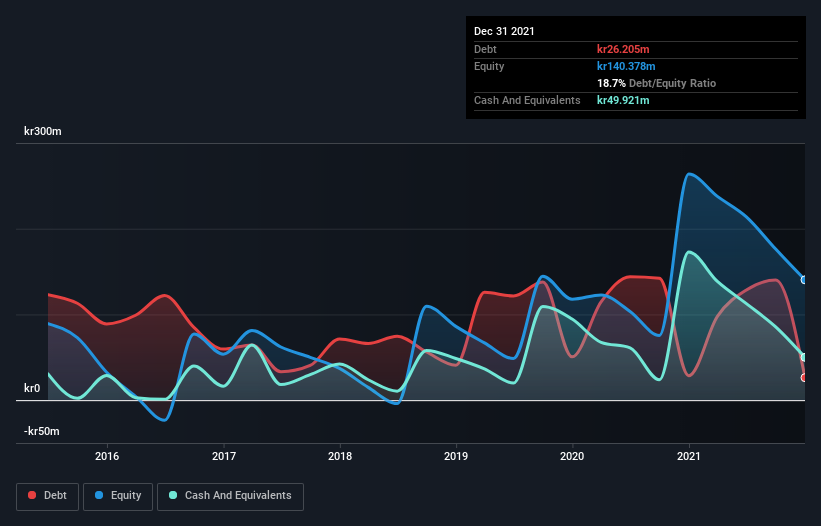Health Check: How Prudently Does Hofseth BioCare (OB:HBC) Use Debt?
Legendary fund manager Li Lu (who Charlie Munger backed) once said, 'The biggest investment risk is not the volatility of prices, but whether you will suffer a permanent loss of capital.' So it might be obvious that you need to consider debt, when you think about how risky any given stock is, because too much debt can sink a company. Importantly, Hofseth BioCare ASA (OB:HBC) does carry debt. But is this debt a concern to shareholders?
What Risk Does Debt Bring?
Debt assists a business until the business has trouble paying it off, either with new capital or with free cash flow. Part and parcel of capitalism is the process of 'creative destruction' where failed businesses are mercilessly liquidated by their bankers. However, a more common (but still painful) scenario is that it has to raise new equity capital at a low price, thus permanently diluting shareholders. Of course, the upside of debt is that it often represents cheap capital, especially when it replaces dilution in a company with the ability to reinvest at high rates of return. The first step when considering a company's debt levels is to consider its cash and debt together.
View our latest analysis for Hofseth BioCare
How Much Debt Does Hofseth BioCare Carry?
As you can see below, Hofseth BioCare had kr26.2m of debt at December 2021, down from kr28.5m a year prior. But it also has kr49.9m in cash to offset that, meaning it has kr23.7m net cash.

A Look At Hofseth BioCare's Liabilities
According to the last reported balance sheet, Hofseth BioCare had liabilities of kr150.9m due within 12 months, and liabilities of kr124.7m due beyond 12 months. Offsetting these obligations, it had cash of kr49.9m as well as receivables valued at kr23.5m due within 12 months. So it has liabilities totalling kr202.2m more than its cash and near-term receivables, combined.
Given Hofseth BioCare has a market capitalization of kr1.43b, it's hard to believe these liabilities pose much threat. However, we do think it is worth keeping an eye on its balance sheet strength, as it may change over time. Despite its noteworthy liabilities, Hofseth BioCare boasts net cash, so it's fair to say it does not have a heavy debt load! When analysing debt levels, the balance sheet is the obvious place to start. But you can't view debt in total isolation; since Hofseth BioCare will need earnings to service that debt. So if you're keen to discover more about its earnings, it might be worth checking out this graph of its long term earnings trend.
In the last year Hofseth BioCare wasn't profitable at an EBIT level, but managed to grow its revenue by 27%, to kr88m. Shareholders probably have their fingers crossed that it can grow its way to profits.
So How Risky Is Hofseth BioCare?
We have no doubt that loss making companies are, in general, riskier than profitable ones. And we do note that Hofseth BioCare had an earnings before interest and tax (EBIT) loss, over the last year. Indeed, in that time it burnt through kr100m of cash and made a loss of kr126m. Given it only has net cash of kr23.7m, the company may need to raise more capital if it doesn't reach break-even soon. With very solid revenue growth in the last year, Hofseth BioCare may be on a path to profitability. By investing before those profits, shareholders take on more risk in the hope of bigger rewards. There's no doubt that we learn most about debt from the balance sheet. However, not all investment risk resides within the balance sheet - far from it. To that end, you should learn about the 3 warning signs we've spotted with Hofseth BioCare (including 2 which are significant) .
If, after all that, you're more interested in a fast growing company with a rock-solid balance sheet, then check out our list of net cash growth stocks without delay.
Valuation is complex, but we're here to simplify it.
Discover if Hofseth BioCare might be undervalued or overvalued with our detailed analysis, featuring fair value estimates, potential risks, dividends, insider trades, and its financial condition.
Access Free AnalysisHave feedback on this article? Concerned about the content? Get in touch with us directly. Alternatively, email editorial-team (at) simplywallst.com.
This article by Simply Wall St is general in nature. We provide commentary based on historical data and analyst forecasts only using an unbiased methodology and our articles are not intended to be financial advice. It does not constitute a recommendation to buy or sell any stock, and does not take account of your objectives, or your financial situation. We aim to bring you long-term focused analysis driven by fundamental data. Note that our analysis may not factor in the latest price-sensitive company announcements or qualitative material. Simply Wall St has no position in any stocks mentioned.
About OB:HBC
Hofseth BioCare
Produces and sells health nutritional products for humans and pets in Norway, the United Kingdom, France, Belgium, Italy, Germany, rest of Europe, Japan, Asia, and the United States.
Low risk and slightly overvalued.
Market Insights
Community Narratives





